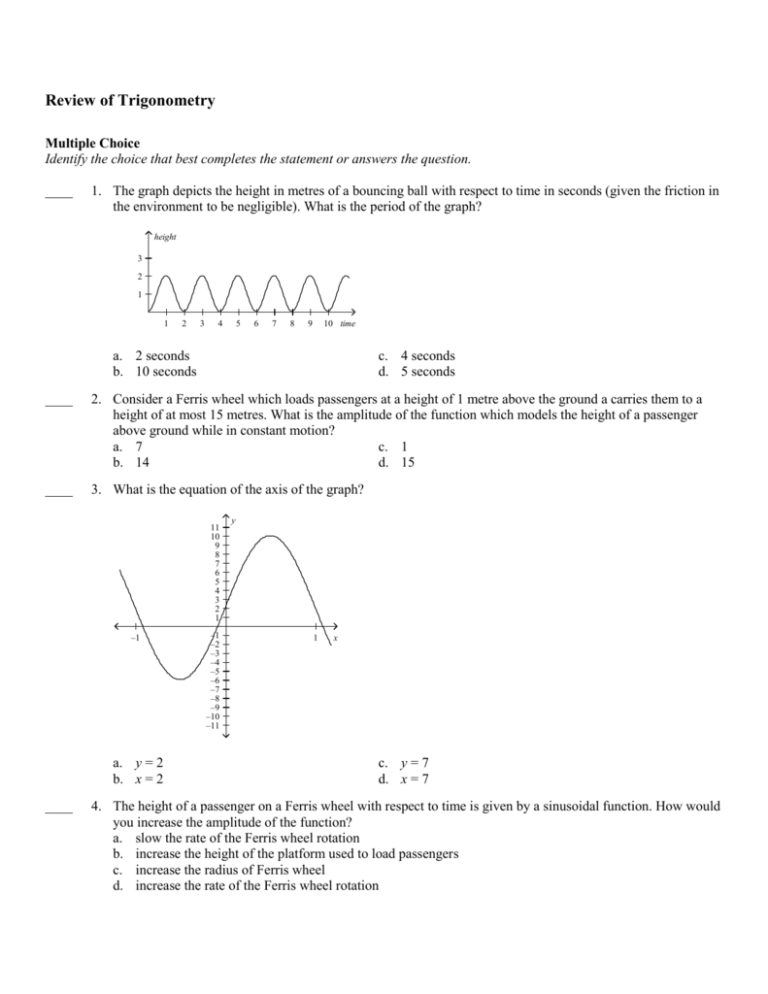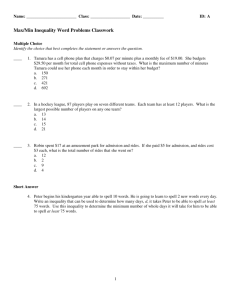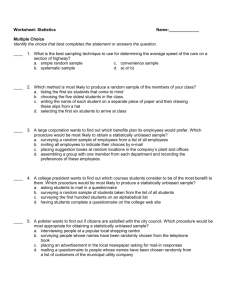Review of Trigonometry
advertisement

Review of Trigonometry Multiple Choice Identify the choice that best completes the statement or answers the question. ____ 1. The graph depicts the height in metres of a bouncing ball with respect to time in seconds (given the friction in the environment to be negligible). What is the period of the graph? height 3 2 1 1 2 3 4 5 6 7 8 9 10 time a. 2 seconds b. 10 seconds c. 4 seconds d. 5 seconds ____ 2. Consider a Ferris wheel which loads passengers at a height of 1 metre above the ground a carries them to a height of at most 15 metres. What is the amplitude of the function which models the height of a passenger above ground while in constant motion? a. 7 c. 1 b. 14 d. 15 ____ 3. What is the equation of the axis of the graph? 11 10 9 8 7 6 5 4 3 2 1 –1 a. y = 2 b. x = 2 ____ –1 –2 –3 –4 –5 –6 –7 –8 –9 –10 –11 y 1 x c. y = 7 d. x = 7 4. The height of a passenger on a Ferris wheel with respect to time is given by a sinusoidal function. How would you increase the amplitude of the function? a. slow the rate of the Ferris wheel rotation b. increase the height of the platform used to load passengers c. increase the radius of Ferris wheel d. increase the rate of the Ferris wheel rotation Short Answer 5. A Ferris wheel loads passengers at a height 1 metre above the ground and carries them to height at most 15 metres above the ground. The wheel rotates at a rate of 1 revolution every 2 minutes. Draw the graph of an approximate function which models the height of a passenger on the Ferris wheel with respect to time. Make sure to include two periods. 6. What is the equation of the axis of the function? y 1 2 3 4 5 6 7 8 9 10 x –7 –8 –9 7. What is the amplitude of the graph? What is the equation of the axis? y 14 13 12 11 10 9 8 7 6 5 –4 –3 –2 –1 1 x 8. Find the amplitude, period and equation of axis of the sinusoidal function. y 7 6 5 4 3 2 1 1 x Problem 9. What is the equation in the form y = asin k( + b) + d that best models the data in the graph below? 10. A radio transmission tower sways sinusoidally in high winds. The top of the tower moves 75 cm back and forth from its normal vertical position. A motion detector measures that its top is 75 cm to the left of vertical at t = 10 s and 75 cm to the right of vertical at t = 40 s. Determine the simplest cosine function that models this motion. 11. The average monthly temperature for a location in Ontario as a function of month number can be modelled using the equation y = acos k(+ b) + d. If the highest average monthly temperature is 20°C and the lowest average monthly temperature is –10°C, which occurs in January (month 0) with an annually repeating pattern, write the simplest equation that models this relationship and sketch its graph. 12. The depth of the water in an ocean harbour varies due to the tides and can be modelled using the equation y = asin k( + b) + d. High tide occurs at 5:00 A.M. with a water depth of 16 m and low tide occurs at 5:00 P.M. with a water depth of 5 m. (a) Determine the equation that models this relationship if t = 0 at midnight. (b) Sketch its graph. (c) Determine the water depth at 2:00 P.M. 13. A ride at Canada's Wonderland called Jet Scream is like a large pendulum that swings back and forth periodically with a constant amplitude during the middle part of the ride. During this part of the ride, the passenger section makes six complete swings in one minute. The passengers are 2.5 m above the ground at the lowest point and 6.0 m above the ground at the highest point. Let t = 0 at the highest point of the ride. (a) Write the equation that models this motion in the form y = asin k( + b) + d. (b) Calculate the height of the passengers at 1.4 min. 14. An electronics engineer uses an oscilloscope to analyze the voltage signal in an electronic circuit. The oscilloscope produces a graph on its display screen as shown below. The vertical scale is in millivolts and the horizontal scale is in milliseconds. Use the following formulas to find the RMS voltage, VRMS, and the frequency, f, of the signal. VRMS = 2 amplitude ; 15. A bicycle wheel with diameter 0.5 metres is spinning at a constant rate of 2 revolutions per second. Draw an approximate function which models the height of a point on the wheel above the ground with respect to time. (include at least two cycles) 16. A boy on a Ferris wheel that turns at a constant rate of 1 revolution every 3 minutes is at most 23 metres above the ground and at least 2 metres above the ground. Construct a graph that models the boy’s height above ground with respect to time. 17. Sketch a graph of the function sin(x – 45) + 2. 18. Sketch a graph of the function sin(x + 30) – 3. 19. Sketch a graph of the function sin(x + 45) – 6. 20. Sketch a graph of the function f(x) = –2sin x. Review of Trigonometry Answer Section MULTIPLE CHOICE 1. ANS: A PTS: 1 REF: 2. ANS: A PTS: 1 REF: OBJ: 6.3 - Investigating the Sine Function 3. ANS: A PTS: 1 REF: OBJ: 6.3 - Investigating the Sine Function 4. ANS: C PTS: 1 REF: OBJ: 6.4 - Comparing Sinusoidal Functions Application Thinking OBJ: 6.2 - Periodic Behaviour Application Thinking SHORT ANSWER 5. ANS: height 15 14 13 12 11 10 9 8 7 6 5 4 3 2 1 1 2 3 minutes PTS: 1 REF: Thinking 6. ANS: The equation of the axis is y = –8. OBJ: 6.2 - Periodic Behaviour PTS: 1 REF: Application OBJ: 6.3 - Investigating the Sine Function 7. ANS: The amplitude is 4. The equation of the axis is y = 10. PTS: 1 REF: Thinking OBJ: 6.3 - Investigating the Sine Function 8. ANS: The amplitude is 2, the period is 1 and the equation of the axis is y = 3. PTS: 1 REF: Knowledge and Understanding OBJ: 6.4 - Comparing Sinusoidal Functions PROBLEM 9. ANS: As seen in the graph, the amplitude is 4, so a = 4. The central axis is y = –1, so the graph is shifted down by – 1 and d = –1. The period is 180°, making k = 2. Finally, the graph is horizontally shifted 30° to the right, so b = 30°. Therefore, the equation is . PTS: 1 DIF: U/C REF: Knowledge and Understanding OBJ: 5.7 Modelling Periodic Phenomena STA: TF4.01 TOP: Modelling Periodic Functions 10. ANS: From the information given, the amplitude is 75 cm. Since it takes 30 s to move from the far left position to the far right position, the period is double this time or 60 s. Normally, the cosine is at its maximum value at t = 0. In this case it is at 10 s, therefore, the phase shift is –10 s. In this model, the normal position is when the displacement is at 0 cm, so there is no vertical shift in the equation (d = 0). Therefore, a = 75, , b = –10, and the equation is PTS: 1 DIF: U/C REF: Application OBJ: 5.7 Modelling Periodic Phenomena STA: TF4.04 TOP: Modelling Periodic Functions 11. ANS: Using the information given, we can calculate the required constants. |a| = 20 – 5 = 15; however, it is negative because the graph starts at negative values. b = 0 because the graph has its minimum value at time zero when the cosine function is used. Therefore, the equation is y = –15cos 0.52 + 5. PTS: 1 STA: TF4.04 12. ANS: DIF: U/C REF: Application TOP: Modelling Periodic Functions OBJ: 5.7 Modelling Periodic Phenomena (a) Using the information given in the question, the constants may be determined. The water would be at the middle depth 6 h before 5:00 A.M. or at –1 h, so b = 1. (a) Therefore, the equation is d = 5.5sin 0.26(t + 1) + 10.5, where d is the depth in metres and t is the time in hours. (b) (c) 2:00 P.M., t = 14, so d = 5.5sin 0.26(14 + 1) + 10.5 At 6.7 m PTS: 1 DIF: U/C REF: Thinking/Inquiry/PS OBJ: 5.7 Modelling Periodic Phenomena STA: TF4.04 TOP: Modelling Periodic Functions 13. ANS: (a) Using the information given in the question, the constants may be determined. To use the sine function to model this motion, the graph needs to be shifted by left, so b = 2.5. period or 2.5 s to the Therefore, the equation is h = 1.75sin 0.63(t + 2.5) + 4.25, where h is the height in metres and t is the time in seconds. (b) PTS: 1 DIF: U/C REF: Thinking/Inquiry/PS OBJ: 5.7 Modelling Periodic Phenomena STA: TF4.04 TOP: Modelling Periodic Functions 14. ANS: From the graph, distance between adjacent x-intercepts is 400 ms, so the period is 400 ms. RMS voltage = VRMS = 2 amplitude = 2 10 14.14 mV PTS: 1 STA: TF4.04 15. ANS: DIF: U/C REF: Application TOP: Modelling Periodic Functions OBJ: 5.7 Modelling Periodic Phenomena height 0.5 time If the point on the wheel begins in the downward position, it should increase to a height at most 0.5 metres then decrease back to an initial height of 0 metres in 0.5 seconds. Included are 2 cycles for a total interval of 1 second. PTS: 1 REF: Application OBJ: 6.2 - Periodic Behaviour 16. ANS: The function is sinusoidal with amplitude 10.5 metres and period 3 minutes. y 23 22 21 20 19 18 17 16 15 14 13 12 11 10 9 8 7 6 5 4 3 2 1 1 2 3 4 x PTS: 1 REF: Thinking OBJ: 6.3 - Investigating the Sine Function 17. ANS: The graph should transform sin x by translating up 2 units and to the right 45. y 4 3 2 1 90 180 270 360 x PTS: 1 REF: Thinking OBJ: 6.5 - Transformations of the Sine Function: f(x) = sin(x - c) and f(x) = sin x + d 18. ANS: The graph should translate the function sin x to the left 30 and down 3 units. y 90 180 270 360 x –1 –2 –3 –4 PTS: 1 REF: Thinking OBJ: 6.5 - Transformations of the Sine Function: f(x) = sin(x - c) and f(x) = sin x + d 19. ANS: The graph should be a transformation of sin x translated to the left 45 and down 6. y 90 180 270 360 x –5 –6 –7 PTS: 1 REF: Application OBJ: 6.5 - Transformations of the Sine Function: f(x) = sin(x - c) and f(x) = sin x + d 20. ANS: The graph retains the same x-intercepts as sin x, but the amplitude is 2 and the function is reflected over the xaxis. y 2 1 –270 –180 –90 90 180 270 x –1 –2 PTS: 1 REF: Thinking OBJ: 6.6 - More Transformations of sin x: f(x) = a sin x








